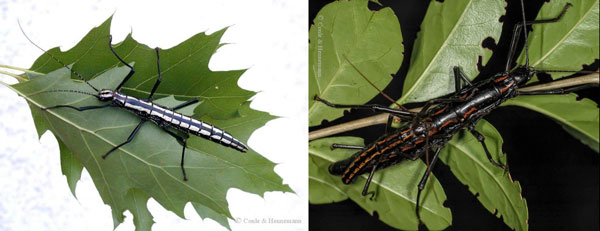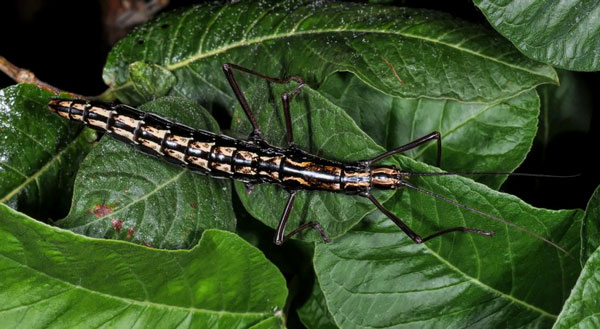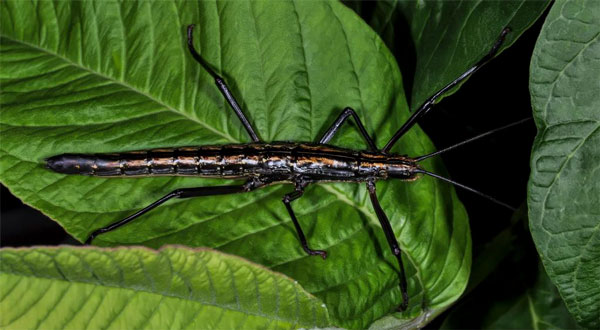Why do we keep our phasmid cultures pure?
- Until just some years ago, phasmid breeders considered it a great idea to mix the "new blood" of a fresh "out-of-nature" population with an "old" captive-bred culture. Without considering whether both populations are conspecific (= the same species) and fully "biologically compatible".
- But mixing a fresh "out-of-nature" population with an "old" captive-bred culture is like putting a new engine in an old, dented, shabby car. It's not really a good idea...
- Furthermore, things are a bit more complex than this simplistic approach suggests.
- There is the age-old controversy amongst biologists - "What is a species after all?".
- One might think that taxonomists have a clear idea about what a species is, but as John Wilson puts it "there are n+1 species concepts in a room with n biologists".
- So there is just no such species concept which does impose itself inevitably and "universally" and thus would be accepted far and wide.
- For example, the biological species concept is widely known even amongst non-biologists. This concept defines a species as "groups of actually or potentially interbreeding natural populations which are reproductively isolated from other such groups" (Mayr, 1942). Yet no phasmid taxonomist has ever tested this concept when describing a new species - due to practical reasons. Thus this concept has no significance in taxonomy in general and in phasmid taxonomy in particular. The consequence is, that we don't know whether different valid species could actually hybridize - or not. To avoid any possibilities, closely related species (e.g. species of the same genus) must strictly be kept separate.
- Then there is the morphological species concept, which groups individuals into different taxa based on their outer appearance (morphology). This concept is widely applied by (phasmid) taxonomists due to practical reasons again - usually, they have nothing but dead, preserved specimens for their work. Just as this concept leaves some room for personal interpretation and choice of emphasis, this inevitably leads to divergent opinions amongst taxonomists (sometimes even fueled by personal animosities).
- More recently, our increasing knowledge about cryptic species, siblings species, species groups and convergent evolution suggests that defining a species based solely on its morphology can be tricky - to say the least. A "very similar" or "identical" morphology could be a strong indication but no proof that two populations are closely related or conspecific.
- There is cause for circumspection when comparing geographically well-separated populations. For example, morphologically rather similar populations from different islands or which are separated by a long distance or geographical barriers (mountain ranges, rivers, arid areas). There are indications that conspecific yet geographically well-separated populations might not be fully "biologically compatible" anymore. Examples are Ensatina eschscholtzii or Phylloscopus trochiloides.
- Superficially the phylogenetic species concept seems to offer a better way to distinguish species. But actually, the species problem is far from being solved. The age-old question just reappears with a new livery ... Which degree of genetic divergence is "proof" enough that two populations are different species? Humans and chimpanzees are phenotypically very different, and who wouldn't agree that these are two different species? Yet their DNA is about 98.8% the same. So where to draw the line between species when it comes to genetic divergence? Different taxonomists will have different ideas about this, and the quarrel will go on.
- To add to the confusion, there are even more species concepts. More than 20 concepts are being discussed.
- What about sub-species? Is it a valid and elegant solution to honour minor differences between well-separated, yet conspecific populations? Or is this just the last resort for unassertive taxonomists?.
- So no wonder that defining/describing a new species is a controversial subject, as no species concept or taxonomical approach can claim to be universally and true. Nor is there any absolutely wrong concept.
- Taxonomy is (like other scientific disciplines too) our human attempt to understand the complexity of nature - by overlaying the world with a grid to measure, categorize, understand and apprehend what is going on around us. It is like sieving through some stuff, to get order and control. A group of biologists (lumpers) prefers a rather coarse sieve. While another group of biologists (splitters) apply a finer sieve. Thus lumpers will inevitably end with a lower number of distinctly separated groups (or species) than splitters. But who is right, who is wrong? Neither approach is totally wrong, nor totally right. Splitters tend to ignore the unity in diversity, while lumpers tend to ignore the diversity in unity.
- Here are some videos, which give some basic info on this subject and its controversy:
- Two well-separated populations might be considered to be conspecific (according to the biological, morphological and/or phylogenetic species concepts), still they will still show consistent minor differences. The worldwide human society is good proof of that. And why would it be different in the world of phasmids?
- All this shows that there is good cause for serious phasmid breeders to keep cultures of potentially conspecific from well-separated locations pure and strictly separate - at all stages of their development. Keeping cultures pure is a way to preserve nature's astounding diversity and its scientific value. Who knows what future taxonomical in-depth studies will come up with - sooner or later?
- Finally, let's have a look at the E. tiaratum cultures in Europe. They thrived for 50 - 60 years in Europe and this species was considered to be very easy to breed - a "beginner species". Yet some years ago, breeders across Europe "suddenly" reported problems with Extatosoma tiaratum. Interestingly these problems arose just when "new" E. tiaratum cultures from Australia became available in Europe. And many breeders frantically mixed their old cultures with these newly imported cultures. Is it just a coincidence, or could it be that these newly imported cultures were not fully "biologically compatible" with the old culture, which led to weak hybrid cultures? Just a thought ...
How to keep our cultures pure?
- Use a culture's full scientific name, and make sure that you have the scientific name correctly.
- Never ever use common names (like "prickly stick insect" etc.).
- If you know the exact geographical origin/provenance of your culture, then use the full scientific name always with the provenance as an affix. For example Phyllium rubrum "Tapah",
- Phyllium rubrum = species name.
- "Tapah" = provenance affix (indicates that this pure culture originates from the hills around Tapah in Peninsular Malaysia).
- If you import or collect a new culture yourself, make it a point to add the provenance affix to the species name when you distribute your new culture to other breeders. Be as specific as possible when choosing the provenance. Just the country name is not good enough!
- If there are several closely related yet significantly different cultures from the same provenance, then one can add additional morphological features to the affix. For example Phyllium rubrum "Tapah" which first had been in culture as Phyllium sp. "Tapah, red coxae" - cause their red coxae are a distinctive feature.
- If you do not know the exact geographical origin/provenance of your culture, then please be honest about it. Crooks only would label a culture of unknown origin with a specific location.
- Do not keep two species of the same genus in the same cage (see information above). We just don't know how easily different species hybridize (see example below).
- Keep cultures from well-separated geographical origins strictly separate at all stages (during incubation, nymphs and adults).
- It is best, anyway, to keep just one phasmid species per cage. The population density even in the biggest cage is still much higher than it is out in nature (for most species).
- Make sure that your cages and incubation boxes are escape-proof.
- Use physically separated incubation boxes, so that there is no possibility of mixing up hatching nymphs of related species.
- Nymphs which escape and roam in the phasmid room outside the cage can not be put back into a cage with a pure culture. Especially if we are breeding similar species (belonging to the same genus). Even from eggs which lay in a dark and dusty corner of our phasmid room nymphs can hatch, even after one or two years.
An example - Anisomorpha buprestoides x Anisomorpha paromalus
Some time ago our team leader Oskar made an interesting experiment. He intentionally kept together an Anisomorpha buprestoides "Ocala" (Florida, USA) female with an Anismorpha paromalus (Belize) male.

They mated readily, and the resulting eggs were incubated to see whether there would be male offspring and what the offspring's colour might be. And Oskar found that:
- F1 hybrid generation hatching ratio was "normal".
- F1 hybrid generation showed normal vitality and grew up well.
- F1 hybrid generation with male and female specimens.
- F1 hybrid generation was variably coloured, basically a variable blend of both species' colouration (see pics below).
- F2 hybrid generation eggs hatched too (though this generation has not been checked for the presence of males).
This experiment shows how easily two widely accepted distinct and valid species can hybridize. And as we do not know the hybridization potential in other taxa, therefore we are well advised to keep species of the same genus strictly separate. At all stages of their development.

